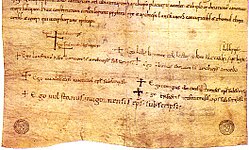Lanfranc

Lanfranc (1005 x 1010 at Pavia — 24 May 1089 at Canterbury) was a cleric, teacher and jurist who became Archbishop of Canterbury under William the Conqueror.[1]
This celebrated Italian jurist gave up his career to become a monk at Bec in Normandy. In 1070 he became the Archbishop of Canterbury in England. This was the peak of an extraordinary life.
Life
Lanfranc was born in the early years of the 11th century at Pavia in Italy. His father, Hanbald, held a rank equivalent to a magistrate. He was orphaned at an early age. Lanfranc was trained in the liberal arts. He crossed the Alps, and took up the role of teacher in France and eventually in Normandy. About 1039 he became the master of the cathedral school at Avranches. He taught for three years with much success.
In 1042 he gave this up to become a monk in the newly founded Bec Abbey. He became the first prior of Bec Abbey in 1045.[2] He became a friend of William, Duke of Normandy and by 1050 his counselor.[2] Lanfranc then became the abbot of St Stephen in Normandy.[3]
In 1067, when Maurilius, Archbishop of Rouen, died, Lanfranc declined the position.[4] He would not have been able to do so without the consent of William I. It is likely William had something bigger in mind for Lanfranc. In 1070 Stigand, the Archbishop of Canterbury was deposed by papal legates. William brought Lanfranc from Normandy to England to become the Archbishop of Canterbury.[5]
Lanfranc Media
Signatures at the council of Winchester (1072). The large crosses are the signatures of William and Matilda, the one under theirs is Lanfranc's, and the other bishops' are under his.
References
| Wikimedia Commons has media related to Lua error in Module:Commons_link at line 62: attempt to index field 'wikibase' (a nil value).. |
- ↑ Latin: [Lanfrancus] Error: {{Lang}}: text has italic markup (help). He is also variously known as Lanfranc of Pavia (Italian: [Lanfranco di Pavia] Error: {{Lang}}: text has italic markup (help)), Lanfranc of Bec (French: [Lanfranc du Bec] Error: {{Lang}}: text has italic markup (help)), and Lanfranc of Canterbury (Latin: [Lanfrancus Cantuariensis] Error: {{Lang}}: text has italic markup (help)).
- ↑ 2.0 2.1 Julie Potter, 'The Benefactors of Bec and the politics of priories', Anglo-Norman Studies XXI: Proceedings of the Battle Conference 1998, ed. Christopher Harper-Bill (Woodbridge: Boydell Press, 1999), p. 182
- ↑ Frank Stenton 1989. Anglo-Saxon England. 3rd ed, Oxford; New York: Oxford University Press, p. 662.
- ↑ William Richard Wood Stephens 1901. The English church from the Norman conquest to the accession of Edward I (1066-1272). London: Macmillan, pp. 8–9
- ↑ Louise Creighton 1882. A first history of England. London: Rivingtons, p. 67
